 From:
From:
Boženka Vondruška
To:
Kevin Hoar
Subject:
Re: Student view
Date:
Thursday, 21 March 2024 12:16:53 PM
Attachments:
Outlook-iq3wntao.png
Thanks
From: Kevin Hoar <[email address]>
Date: Thursday, 21 March 2024 at 12:07 PM
To:
Boženka Vondruška
<[email address]>
Subject: Re: Student view
Thanks
for the critiques.
Cheers.
Kevin
Kevin Hoar | National Assessment Facilitator
External Assessment Team
Assessment Division | Wāhanga Aromatawai
New Zealand Qualifications Authority | Mana Tohu Mātauranga o Aotearoa
(
@ [email address]
:
www.nzqa.govt.nz
125 The Terrace, PO Box 160,
*
Wellington, 6140
He rerekē tatou katoa – awhi i te oranga ki te katoa
We are all different – embrace life to the fullest
From:
Sent: Thursday, 21 March 2024 11:51
To: Boženka Vondruška <[email address]>; Kevin Hoar
<[email address]>
Subject: Student view
Hello Kevin and Bozenka
I've been through the CAA on AM as a student. The whole thing is visually appealing so
students should find it engaging.
I've added some extra considerations to the Screen Dump doc.
The most important is ensuring that all visuals needed to answer a Q are on the same
screen. That may require some alterations in image dimensions.
All the best
 From:
From:
Kevin Hoar
To:
Re: Friday meeting
Date:
Monday, 6 May 2024 12:02:11 PM
Attachments:
Outlook-rfrsqs0d.png
Hi
Yes, please go ahead with your plans to change some of the Outcome 3 responses
from 2023 into multiple choice.
The funding will be part of your examiner contract.
'See' you at 1 pm.
Cheers.
Kevin
Kevin Hoar | National Assessment Facilitator
External Assessment Team
Assessment Division | Wāhanga Aromatawai
New Zealand Qualifications Authority | Mana Tohu Mātauranga o Aotearoa
(
@
[email address]
:
www.nzqa.govt.nz
*
125 The Terrace, PO Box 160, Wellington, 6140
He rerekē tatou katoa – awhi i te oranga ki te katoa We are all different – embrace life to the fullest
From:
Sent: Monday, 6 May 2024 09:03
To: Sue Chalmers <[email address]>; Kevin Hoar <[email address]>
Subject: Friday meeting
Hello Sue and Kevin
I've been mulling over our upcoming meeting on Friday to consider electronic marking of all
the CAA.
Our writing team has previously attempted to draft Outcome 3 items in a style that might be
marked electronically. We ended up abandoning the idea.
I think it would be advantageous to go into the meeting with a couple of examples of how
Outcome 3 items from the 2023 CAAs might look in digital-marking format.
Are you happy for me to spend a couple of hours doing that?
I think examples will help clarify the issues.
Regards


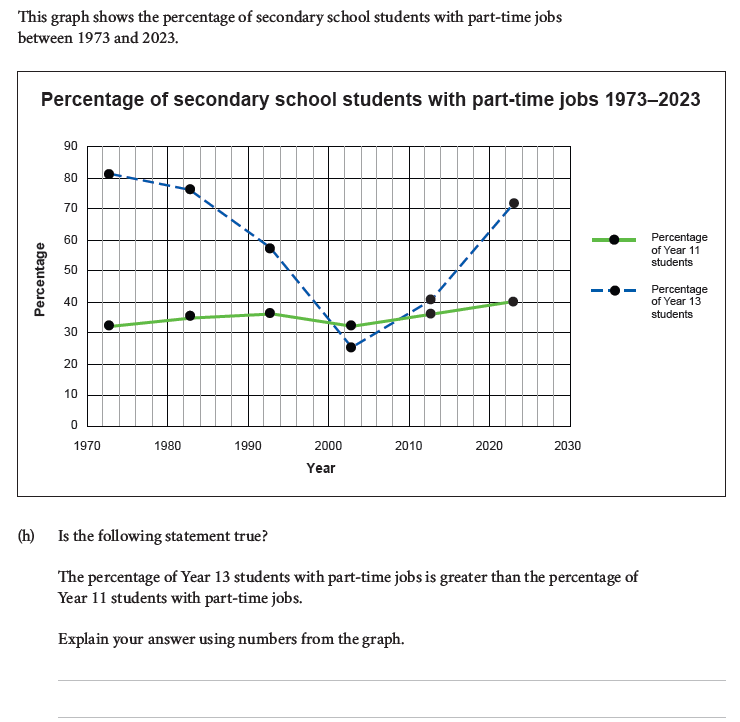
Attempts to rewrite Outcome 3 items in restricted
format so they can be marked digitally.
CAA Term 2 2023 Item 1h
Item as written:
Possible item
(h) Is the fol owing statement true?
The percentage of Year 13 students with part-time jobs is greater than the percentage of Year 1
students with part-time jobs.
Choose
two answers that are correct:
a) No. In the year 2001, 25% of Year 13 students had part-time jobs compared to 32% of
Year 11 students. (Year incorrect but percentages are correct)
b) Yes. In every year except 2003, a greater percentage of Year 13 students have part-time
jobs than Year 11 students. (Describes overal trend so correct)
c) Yes. In 2023, 72% of Year 13 students had part-time jobs compared to 40% of Year 11
students. (Correct reading of a specific year)
d) No. The solid line shows the percentage of Year 11 students, and it does not change
much. (Correct observation but does not answer the Q).
e) Yes. The percentage of Year 13 students is usual y 60% or higher but the percentage of
Year 11 students is between 30% and 40% (Correct combination of trend and reading
percentages from the graph.)
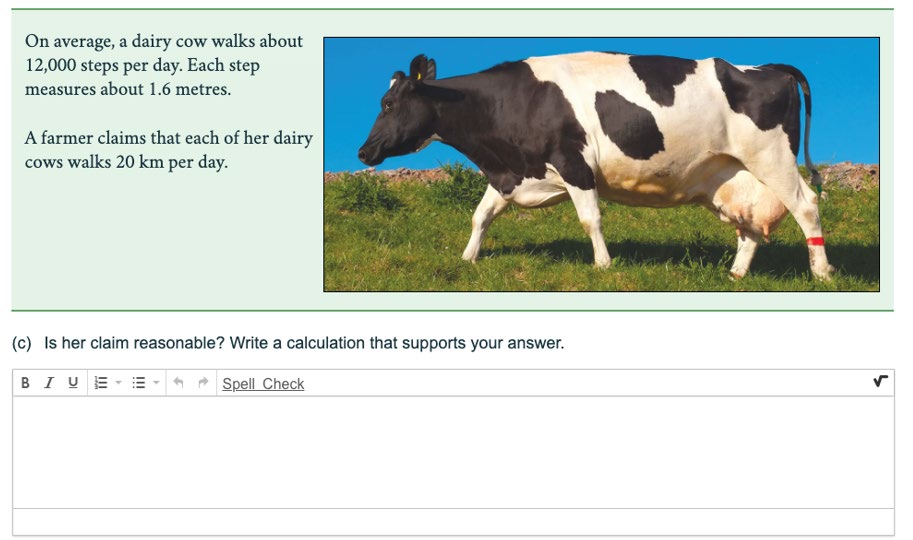
Item 4c Term 4 2023 CAA
Possible item:
In each textbox choose the word or number that makes the answer correct. (Using dropdown
menus)
The claim (is, isn’t) reasonable. The distance can be found by working out (12,000 x 1.6, 20,000 x
1.6). That answer equals (19,200, 32,000) metres. When metres are changed to kilometres the
distance equals (19.2, 1.92) kilometres.
Even simpler
The claim (is, isn’t) reasonable, because 12,000 x 1.6 =
km.
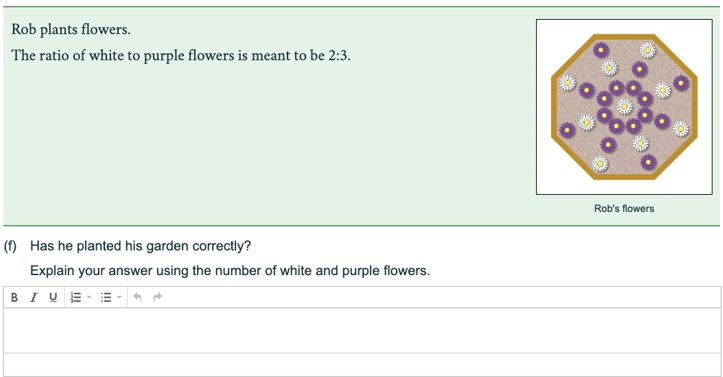
Item 4f Term 2 CAA 2023
Possible Item
Is Rob correct or incorrect? (Drop down Correct/Incorrect)
Choose
one (two?) correct method/s below that supports your answer:
a. 2:3 is the same ratio as 9:16 because 2 x 4½ = 9 and 3 x 4½ = 16.
b. 9 and16 have no common factor, so 9:16 cannot be simplified.
c. 2:3 equals 40% to 60% and the garden has 36% white and 64% purple.
d. 2:3 has the fraction 2 and 9 is 2 of 16.
3
3
e. 2:3 is the same as 18:27 and 9:16 is the same as 18:32.
Issues that arise:
1. Validity
Outcome 3 states “Explain mathematical and statistical responses to situations,”
and students must
“Use evidence to explain the selection of the method and/or
calculation.”
Students in digitally marked items are not explaining, they are responding to pre-
constructed answers.
2. Intel ectual freedom
In current items, students are free to construct an argument that explains their own
thinking. A variety of reasonable answers are given credit. In constrained items they
must respond to the ideas of others. That tends to be more difficult for students.
3. Readability
The items become very wordy, and students need to be highly literate.
4. Reliability
Multi-choice items are vulnerable to guessing and collusion.
 From:
From:
Kevin Hoar
To:
Re: Possible dates for two-hour Numeracy Workshop.
Date:
Monday, 13 May 2024 10:58:48 AM
Attachments:
Outlook-mvqqjiyl.png
Outlook-jqh1or42.png
Outlook-121r35hd.png
Thanks
Cheers.
Kevin
Kevin Hoar | National Assessment Facilitator
External Assessment Team
Assessment Division | Wāhanga Aromatawai
New Zealand Qualifications Authority | Mana Tohu Mātauranga o Aotearoa
(
@
[email address]
:
www.nzqa.govt.nz
*
125 The Terrace, PO Box 160, Wellington, 6140
He rerekē tatou katoa – awhi i te oranga ki te katoa We are all different – embrace life to the fullest
From:
Sent: Monday, 13 May 2024 10:42
To: Kevin Hoar <[email address]>
Cc:
Subject: Re: Possible dates for two-hour Numeracy Workshop.
Hello Kevin and
Here is an invite:
is inviting you to a scheduled Zoom meeting.
Topic:
Zoom Meeting
Time: May 24, 2024 10:00 AM Auckland, Wellington
Join Zoom Meeting
https://us02web.zoom.us/j/86100381180
Meeting ID: 861 0038 1180
Regards
On Mon, May 13, 2024 at 10:11 AM Kevin Hoar <[email address]> wrote:
Hi
.
Do you want to set this meeting up using Zoom, or I can set up a Teams meeting - I will give
you the option.

If you want Zoom, send us both an invitation for 10 am to 12 noon on Friday 24 May 2024.
Cheers.
Kevin
Kevin Hoar | National Assessment Facilitator
External Assessment Team
Assessment Division | Wāhanga Aromatawai
New Zealand Qualifications Authority | Mana Tohu Mātauranga o Aotearoa
(
@
[email address]
:
www.nzqa.govt.nz
*
125 The Terrace, PO Box 160, Wellington, 6140
He rerekē tatou katoa – awhi i te oranga ki te katoa We are all different – embrace life to the fullest
From: Vince Wright
>
Sent: Monday, 13 May 2024 09:45
To: Charles Darr <
Cc: Kevin Hoar <[email address]>
Subject: Re: Possible dates for two-hour Numeracy Workshop.
Hi
and Kevin
Fine by me also.
Regards
On Mon, May 13, 2024 at 9:43 AM
> wrote:
I could do 10-12 on Friday, May 24.
Best,
From: Kevin Hoar <[email address]>
Sent: Friday, May 10, 2024 3:39 PM
Subject: Possible dates for two-hour Numeracy Workshop.
CAUTION: This email originated from outside of NZCER. Do not click links or open attachments unless you recognize the
sender and know the content is safe.
Kia ora
Thank you for attending the Numeracy meeting this afternoon. I thought the meeting was
extremely valuable.

********************************************************************************
This email may contain legally privileged information and is intended only for the addressee. It is
not necessarily the official view or
communication of the New Zealand Qualifications Authority. If you are not the intended recipient
you must not use, disclose, copy or distribute this email or
information in it. If you have received this email in error, please contact the sender immediately.
NZQA does not accept any liability for changes made to this email or attachments after sending by
NZQA.
All emails have been scanned for viruses and content by MailMarshal.
NZQA reserves the right to monitor all email communications through its network.
********************************************************************************
 From:
From:
Kevin Hoar
To:
Subject:
Outcome of the Outcome 3 multiple-choice responses from
College.
Date:
Tuesday, 27 August 2024 3:11:05 PM
Attachments:
Outlook-ynvdtbaw.png
Hi
My new manager would love to see the results that you got from the two classes of
Taupō-Nui-A-Tia College Year 10 kiddies. I can get the TNAT College results from 2023
for the Outcome 3 questions.
Also, your own take of the exercise, relating it to the marking as well as the intentions of
the unit standard.
If you haven't gone through them yet, please let me know an ETA for when you will have
the mahi (work) done - I will need to pass that onto my manager, Kate.
Sorry to add more pressure.
Cheers.
Kevin
Kevin Hoar | National Assessment Facilitator
Co-Requisite Team
Assessment Division | Wāhanga Aromatawai
New Zealand Qualifications Authority | Mana Tohu Mātauranga o Aotearoa
(
@
[email address]
:
www.nzqa.govt.nz
*
125 The Terrace, PO Box 160, Wellington, 6140
He rerekē tatou katoa – awhi i te oranga ki te katoa We are all different – embrace life to the fullest


Trial of Closed Items for Outcome 3
18 August 2024
Research Question:
Do closed answer questions to assess Outcome 3 of the Numeracy Unit
Standard perform in a comparable way to open questions?
Introduction
Unit Standard 32406 Numeracy has three outcomes. Outcomes 1 and 2 are
assessed using closed items that include answer entry into text boxes, and
multiple choice for a limited number of items. In previous years, 2022-
2024, Common Assessment Activities (CAAs) required students to respond
to open items for Outcome 3. Usually, the items involved candidates taking
a position in respect to a claim or calculation and explaining the reason for
supporting that position. The style of these items aligns to the wording of
the outcome:
Explain mathematical and statistical responses to situations.
Open items create potential issues for candidates attempting the CAA and
for markers in assigning “achieved” or “non-achieved” to candidate
responses. Candidates answer the items in a digital format so open items
demand a higher level of computer skills than closed items. The platform
also restricts candidates’ capacity to provide some mathematical symbols,
as no equation editor is available. There are also literacy issues for
candidates in reading the items and creating a written response,
particularly for individuals who find written composition challenging and/or
have English as a second language.
Open items elicit a wide range of responses. Assessment schedules are
prepared and validated through check markers examining several hundred
scripts. Categories of acceptable response are described in the schedule
and exemplified by ‘representative’ examples. Nevertheless, the variety of
responses poses interpretative challenges for markers, especially in
marking partial y correct or unexpected responses.
Over the past two years Outcome 3 items proved difficult for candidates,
with success rates as low as 14% for one item. The sufficiency requirement
for number of items correct in Outcome 3 is a barrier for many candidates.
The writing team previously explored the creation of Outcome 3 items in
closed format twice and there was general agreement that these items
were difficult to create and most frequently did not assess the “Explain”
requirement of Outcome 3. This smal study is an attempt to re-address the
use of closed items. If such items proved sound, the study would
potential y make digital marking possible for the whole CAA and improve
the reliability of assessment.
Method
Items
A pool of Outcome 3 items from 2023 CAAs were chosen for modification
into closed format. Adapting previous items is advantageous as national
success rate data are available which al ows for comparison of success
rate. Knowledge of common candidate responses also supported the
creation of strong distractors in the multiple-choice items. Upon advice
from
from NZCER, multiple-choice was chosen as the
preferred item type. However, two different response types were also
trial ed, true/false and multiple selection, to see if these types also held
promise. The true/false item is a new item, so no previous success rate is
available.
The items are provided in Appendix One at the end of this report, in the
form presented to students.
Students
Students from two classes in a large secondary school anonymously
attempted all eight items during one period in the late morning. The school
services a large town and draws widely from the community of that town, in
both location and socio- economic status. The classes were described a
mixed ability and reflective of a typical mid-range class. 38 students
provided their work, all those present in that period.
Students were allowed as much time as they needed to respond to the
items. General y, most students were finished in about 20 minutes.
Data analysis
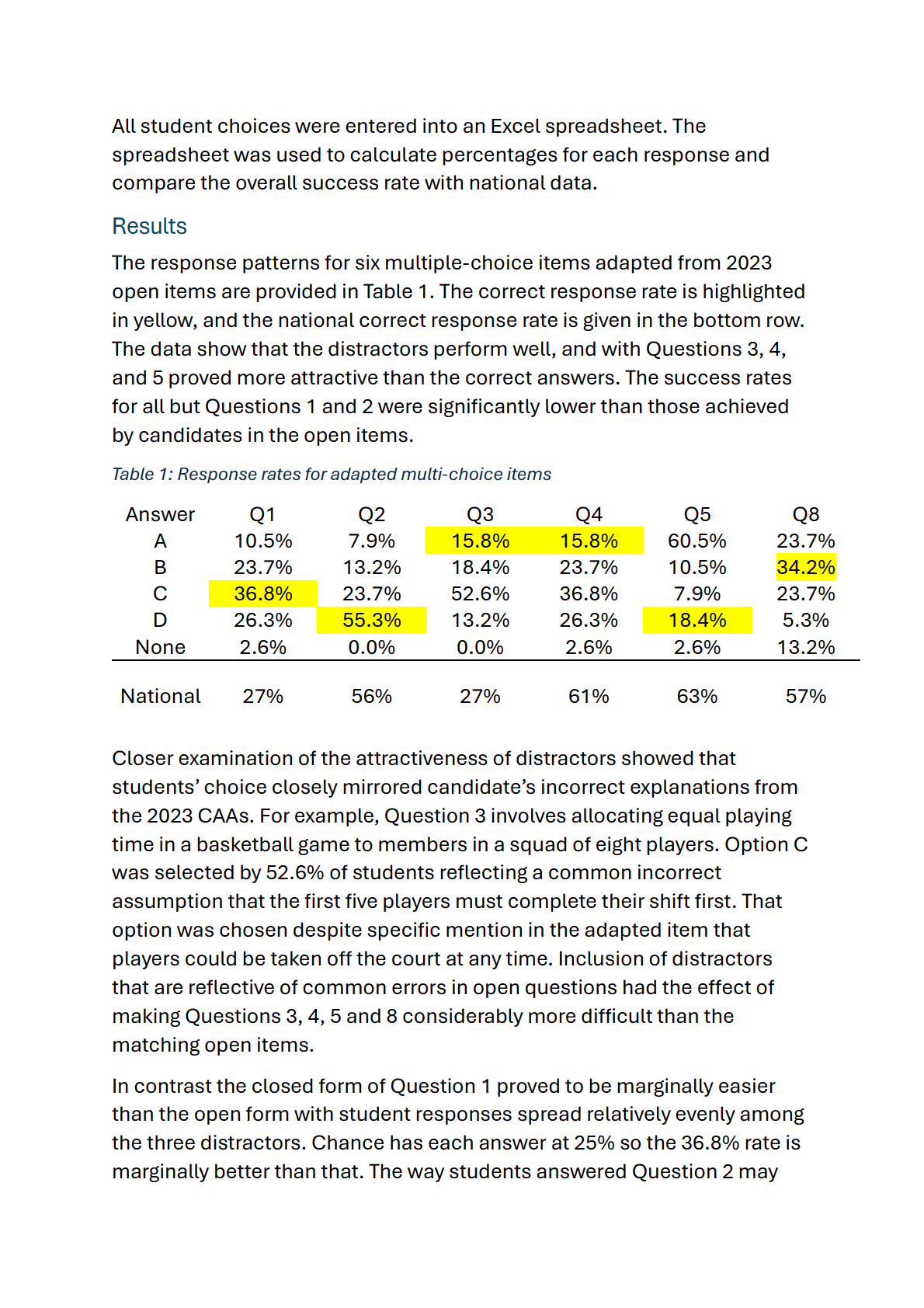
have influenced the success rate. Observations of students working on the
item were that many students used the calculator to check the viability of
each possible answer. Providing calculation choices gave affordance to
that strategy and meant the item was not a valid assessment of Outcome 3.
Question 6 required students to select two of the five given answers. 20 of
the 38 students chose only one option so the instructions did not work. 14
students selected E which most closely reflected the correct answer to the
adapted open question. The 36.8% success rate was higher than the 14%
rate for the open question but only marginally better than chance. Question
7 was a new item that provided four statements about a strategy for
calculating a discounted price for an item of clothing. Students were asked
to choose true or false for each statement. Only five students correctly
decided that all four statements were true. While making four binary
decisions considerably lessons the chances of students being correct by
guessing, a four out of four criteria seems too restrictive. If a ‘three out of
four correct choices’ criteria was applied the rate of success increased to
36.8%.
Discussion
The sample size in this study is smal (n = 38) and the students came from a
single school. Care needs to be taken in generalising the findings to what
might occur with testing on a much larger scale. However, the data indicate
that creating closed Outcome 3 items may be problematic.
In answer to the research question, closed items did
not perform in a
comparable way to open items posed in the same scenario. The trial items
were created with the benefit of knowing common errors candidates
showed on the open items. The distractors in the closed items proved to be
so strong that success rates on relatively easy open items plummeted on
the closed adapted items, to levels equivalent to chance. On the two items
where success rates were similar or marginally better, chance played a part
in the harder item and ability to trial answers with a calculator impacted on
the validity of the easier item.
It is not possible to know the impact that reading volume had on student
success with the closed items. Students in the study were asked to
indicate if they needed assistance with reading and few did. They seemed
to be purposeful y engaged in reading the items. It is a natural trade off that
closed multi-choice items require more reading volume than open items
that require more writing. The shift from open to closed items constitutes
shifting literacy demands from writing to reading. There are often subtleties
of meaning between the wording of correct answers and distractors that
are likely to challenge candidates.
It is also questionable whether closed items are valid assessments of
Outcome 3 that requires candidates to explain. This outcome suggests that
candidates need to construct arguments, not just interpret the arguments
of others.
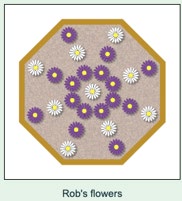
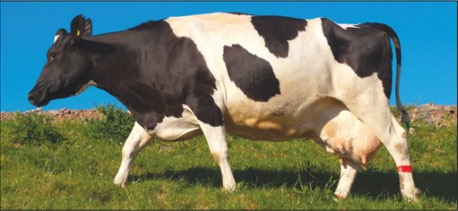
Appendix One
Question One
Rob plants flowers. The ratio of white to purple
flowers is supposed to be 2:3.
This garden has 9 white flowers and 16 purple flowers.
Has Rob planted the garden correctly?
Circle the
best answer.
a. Yes, because there are more purple flowers than white flowers.
b. Yes, because 9 + 16 = 25, and 25 is a multiple of five, just like 2 + 3.
c. No, because multiplying the ratio 2:3 by five gives 10:15, not 9:16.
d. No, because 2:3 means two out of every three flowers should be white.
Question Two
A cow walks about 12,000 steps per day.
Each step is 1.6 metres long.
A farmer claims that the cow walks more
than 20 kilometres per day.
Which answer
best explains whether, or
not, the farmer is correct.
a. The farmer is correct, because 12,000 steps multiplied by 1.6 meters per step
is over 20,000 metres.
b. The farmer is
not correct, because 12,000 steps multiplied by 1.6 meters per
step equals 18 kilometres per day.
c. The farmer is
not correct, because the cow would need to take 1.8-metre-long
steps to equal 20 kilometres.
d. The farmer is correct, because 12,000 steps equal 19,200 metres, which is close
to 20 kilometres.
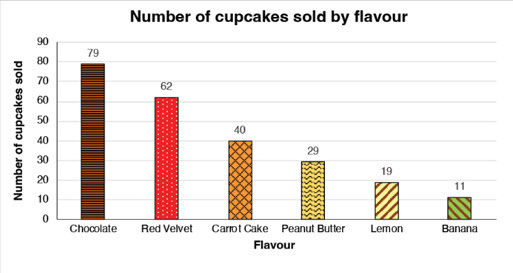
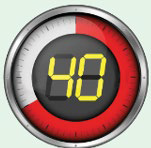
Question Three
A basketball game lasts 40 minutes.
The coach wants all 8 of her players to get
equal time on
court. But only 5 players can be on at the same time.
The coach
can take players on and off the court anytime
she wants. She thinks that each player should get a total of
30 minutes on court.
Choose the
best answer that explains whether, or not, the coach is right.
a. No, because there are 200 player minutes in the whole game. 200 ÷ 8 = 25
minutes per player.
b. Yes, 30 minutes per player means a total of 8 x 30 = 240 player minutes, which is
right.
c. No. If the first 5 players get 30 minutes on court that only leaves 10 minutes for
the other 3 players.
d. No, because 40 x 8 = 320 minutes in total. 320 ÷ 5 = 64 minutes per player.
Question Four
Here is a graph of cupcake sales at a school during Treat Week 2023. In total,
240
cupcakes were sold.
Is it true to say, “
About one third of sales were chocolate-flavoured cupcakes”?
Choose the
best answer that explains whether, or not, the statement is true.
a. Yes, because 79 is very close to one third of 240.
b. Yes, because one third of 240 is exactly 79.
c. Maybe, it depends on whether people like chocolate.
d. No, because one third of 79 is 26.3333, and that doesn’t divide evenly into
240.

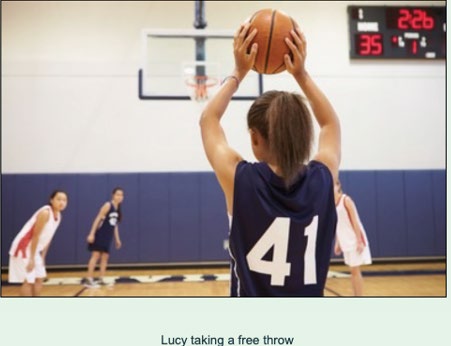
Question Five
Elections in Aotearoa happen every 3
years.
Last year, in 2023, there was an election.
Was 1987 also an election year?
Choose the
best answer.
a. Maybe, perhaps something happened, and people couldn’t vote in 1987.
b. No, because if you count on in threes from 1987, you do not get to 2023.
c. Yes, because 2023 and 1987 are both odd numbers.
d. Yes, because 2023 is 36 years on from 1987, and 36 divides evenly by 3.
Question Six
Julie plays basketball.
Usual y, her success rate for a shot, from the ‘free
throw’ line, is 50%.
She has two shots to take.
Should Julie be confident of getting
at least one
shot in?
Circle
two statements that are true.
a. No, shooting is hard to predict so she might miss both shots.
b. No, it is certain she wil miss at least one of her shots.
c. Maybe, there is zero chance of her getting both shots in.
d. Yes, her expected chance of getting both shots in is 100%.
e. Yes, her expected chance of getting at least one shot in is 75%.
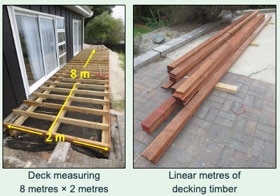

Question Seven
Sue is shopping. The sale discount is 22% off al
items. Sue takes the usual price and multiplies it
by 0.78 to get the sale price.
For example, a jacket usually costs $60 so she
works out 0.78 x 60 = $46.80.
For each statement a-d, choose true or false:
a. Sue’s way of working out the sale price of the jacket is right.
(True/False)
b. Sue finds the sale price of a $100 item by working out 0.78 x 100 = $78
(True/False)
c. 0.78 comes for taking 22% off 100%.
(True/False)
d. If the sale discount was 35%, instead of 22%, Sue would multiply by 0.65.
(True/False)
Question Eight
This deck wil be 8 metres long and 2 metres
wide.
A 1-metre-long strip of wood is called a linear
metre.
Each square metre (m2) of deck takes 11.5
linear metres of wood.
A builder says that about 190 linear metres are needed to build the deck.
Choose the
best answer that explains whether, or not, the builder is right.
a. No, because 8 x 11.5 = 92 linear metres.
b. Yes, because the area of the deck is 10 m2, and 10 x 11.5 = 115 linear metres.
c. No, because the area of the deck is 16 m2, and 16 x 11.5 = 184 linear metres.
d. Yes, because 190 ÷ 11.5 = 16.5 m2, and that allows for waste.
 From:
From:
Kevin Hoar
To:
Subject:
Re: Slight revision
Date:
Wednesday, 24 July 2024 11:49:29 AM
Attachments:
Outlook-x0g40h2y.png
Outlook-efd0tedf.png
Sounds great!
Cheers.
Kevin
Kevin Hoar | National Assessment Facilitator
External Assessment Team
Assessment Division | Wāhanga Aromatawai
New Zealand Qualifications Authority | Mana Tohu Mātauranga o Aotearoa
(
@
[email address]
:
www.nzqa.govt.nz
*
125 The Terrace, PO Box 160, Wellington, 6140
He rerekē tatou katoa – awhi i te oranga ki te katoa We are all different – embrace life to the fullest
From:
Sent: Wednesday, 24 July 2024 11:47
To: Kevin Hoar <[email address]>
Subject: Re: Slight revision
Hi Kevin
Typical teacher...shifting the goalposts.
I think the approach is a good one for the future, not just this round.
Cheers
On Wed, Jul 24, 2024 at 11:43 AM Kevin Hoar <[email address]> wrote:
What - changing my homework on me?!
Lucky, I haven't started my homework yet...
Sometimes it is best to leave things to the last minute or three.
I will have a look over your new material and findings.
Cheers.
Kevin
Kevin Hoar | National Assessment Facilitator
External Assessment Team
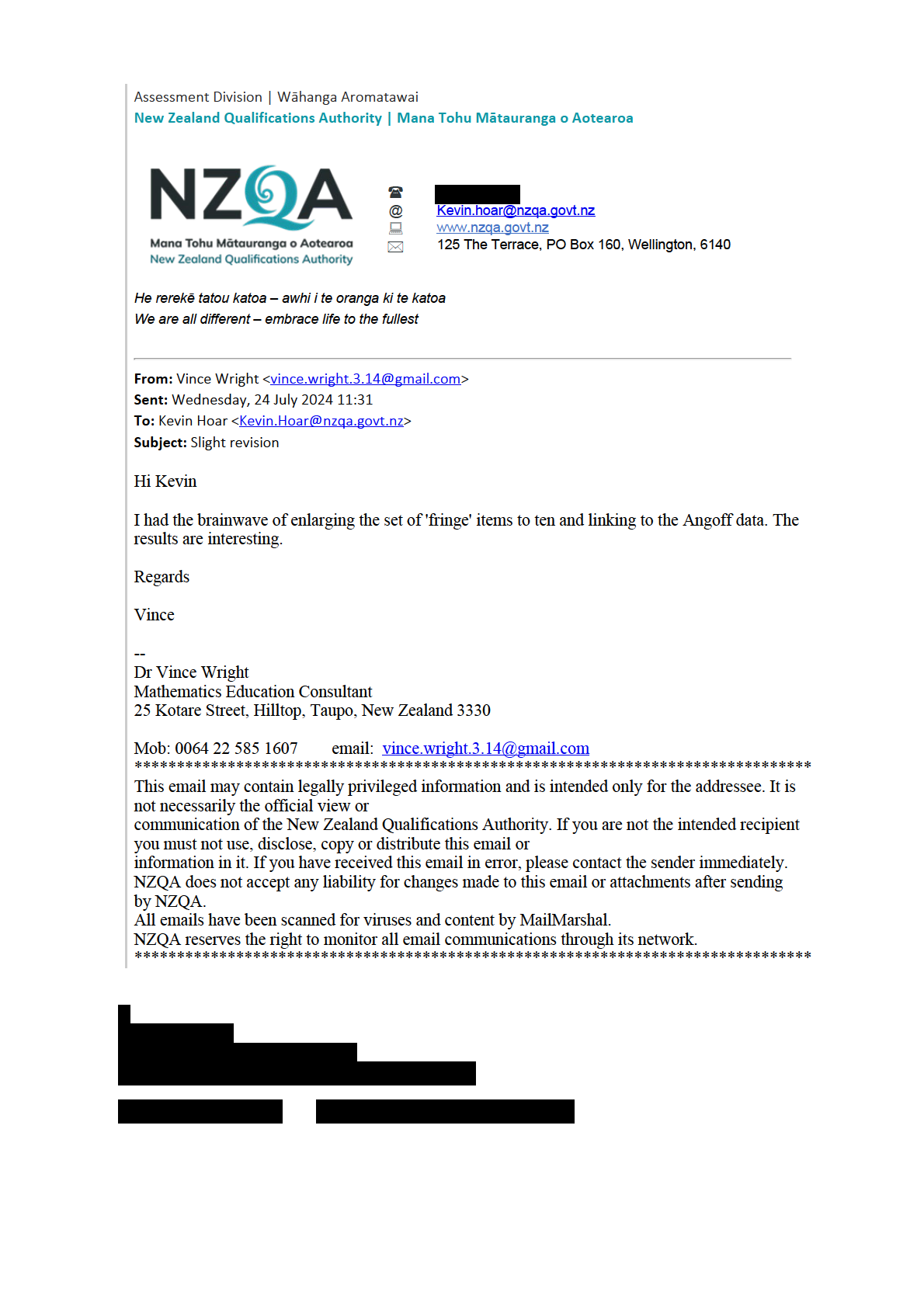
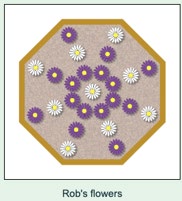
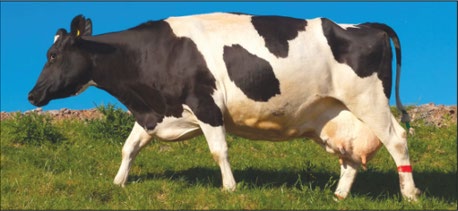
Item 4f Term 2 CAA 2023 (27%)
Rob plants flowers. The ratio of white to purple flowers is
supposed to be 2:3.
This garden has 9 white flowers and 16 purple flowers.
Has Rob planted the garden correctly?
Circle the best answer.
a. Yes, because there are more purple flowers than white flowers.
b. Yes, because 9 + 16 = 25, and 25 is a multiple of five, just like 2:3.
c. No, because multiplying the ratio 2:3 by five gives 10:15, not 9:16
d. No, because 2:3 is 66% white flowers, and 9:16 is 56% white flowers.
e. No, because 9:16 has 7 more purple flowers than white flowers. The numbers should be
one different.
Item 4c Term 4 2023 CAA (56%)
A cow walks about 12,000 steps per day.
Each step is 1.6 meters long.
A farmer claims that the cow walks more than
20 kilometres per day.
Which answer
best explains whether, or not, the farmer is correct.
a. The farmer is correct, because 12,000 steps multiplied by 1.6 meters per step is over
20,000 metres.
b. The farmer is
not correct, because 12,000 steps multiplied by 1.6 meters per step
equals 18 kilometres per day.
c. The farmer is
not correct, because the cow would need to take 1.8 metre steps to equal
20 kilometres.
d. The farmer is correct because 12,000 steps equal 19,200 metres, which is close to 20
kilometres.
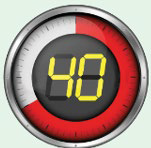

Item 2c Term 4 2023 CAA (27%)
A basketbal game lasts 40 minutes.
The coach wants al 8 players to get equal time on court,
but only 5 players can be on at one time.
The coach thinks that each player should get 30 minutes on the court.
Choose the best answer that explains whether, or not, the coach is right.
a. No, because there are 200 player minutes in the whole game. 200 ÷ 8 = 25 minutes per
player.
b. Yes, 30 minutes per player means a total of 8 x 30 = 240 player minutes which is right.
c. Yes, because 5 of 40 equals 30 minutes per player. Each player gets 30 minutes on
8
court.
d. No, because 40 x 8 = 320 minutes. 320 ÷ 5 = 64 minutes each per player, not 30 minutes.
Item 1f Term 2 2023 CAA (57%)
This deck wil be 8 metres long and 2 metres wide.
A 1-metre-long strip of wood is cal ed a linear metre.
Each square metre (m2) of deck takes 11.5 linear
metres of wood.
A builder says that about 190 linear metres are
needed to build the deck.
Choose the best answer that explains whether, or not, the builder is right.
a. Yes, because 8 x 11.5 = 92 linear metres, and 2 x 11.5 = 23 linear metres.
b. No, because the area of the deck is 10 m2, and 10 x 11.5 = 115 linear metres.
c. Yes, because the total area of the deck is 16 m2, and 16 x 11.5 = 184 linear metres.
d. No, because 190 ÷ 11.5 = 16.5 m2, and the deck has a bigger area than that.
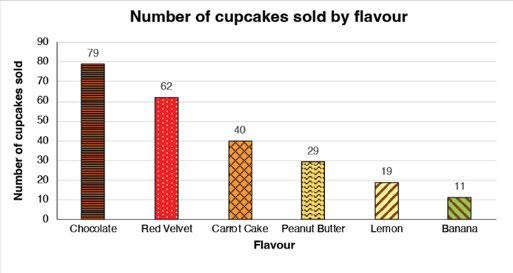

Item 5c Term 2 2023 CAA (61%)
Here is a graph of cupcake sales at a school during Treat Week 2023.
In total 240 cupcakes were sold.
Is it true to say that about one third of sales were chocolate-flavoured cupcakes?
Choose the
best answer that explains whether, or not, the statement is true.
a. Yes, because 79 is very close to one third of 240.
b. Yes, because one third of 240 is exactly 79.
c. No, because 79 is one quarter of 240, not one third.
d. No, because one third of 79 is 26.3333, and that doesn’t divide evenly into 240.
Item 5A Term 4 2023 CAA (63%)
Elections in Aotearoa happen every 3 years.
Last year, in 2023, there was an election.
Was 1987 also an election year?
Choose the best answer.
a. No, because if you count on in threes from 1987, you do not get to 2023.
b. Yes, because 2023 and 1987 are both odd numbers.
c. Yes, because 2023 is 36 years on from 1987, and 36 divides evenly by 3.
d. No, because 2023 is 36 years on from 1987, and 36 is not a multiple of 3.

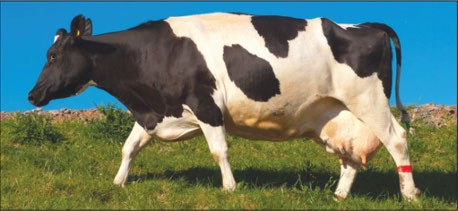
Item 4f Term 2 CAA 2023 (27%)
Rob plants flowers. The ratio of white to purple flowers is
supposed to be 2:3.
This garden has 9 white flowers and 16 purple flowers.
Has Rob planted the garden correctly?
Circle the best answer.
a. Yes, because there are more purple flowers than white flowers.
b. Yes, because 9 + 16 = 25, and 25 is a multiple of five, just like 2:3.
c. No, because multiplying the ratio 2:3 by five gives 10:15, not 9:16
d. No, because 2:3 is 66% white flowers, and 9:16 is 56% white flowers.
e. No, because 9:16 has 7 more purple flowers than white flowers. The numbers should be
one different.
Item 4c Term 4 2023 CAA (56%)
A cow walks about 12,000 steps per day. Each
step is 1.6 meters long.
A farmer claims that the cow walks more than
20 kilometres per day.
Which answer
best explains whether, or not, the farmer is correct.
a. The farmer is correct, because 12,000 steps multiplied by 1.6 meters per step is over
20,000 metres.
b. The farmer is
not correct, because 12,000 steps multiplied by 1.6 meters per step
equals 18 kilometres per day.
c. The farmer is
not correct, because the cow would need to take 1.8 metre steps to equal
20 kilometres.
d. The farmer is correct because 12,000 steps equal 19,200 metres, which is close to 20
kilometres.
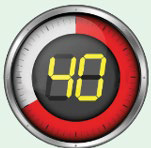
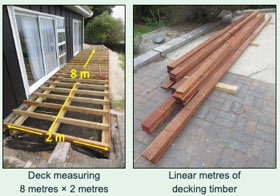
Item 2c Term 4 2023 CAA (27%)
A basketbal game lasts 40 minutes.
The coach wants al 8 players to get equal time on court,
but only 5 players can be on at one time.
The coach thinks that each player should get 30 minutes on the court.
Choose the best answer that explains whether, or not, the coach is right.
a. No, because there are 200 player minutes in the whole game. 200 ÷ 8 = 25 minutes per
player.
b. Yes, 30 minutes per player means a total of 8 x 30 = 240 player minutes which is right.
c. Yes, because 5 of 40 equals 30 minutes per player. Each player gets 30 minutes on
8
court.
d. No, because 40 x 8 = 320 minutes. 320 ÷ 5 = 64 minutes each per player, not 30 minutes.
Item 1f Term 2 2023 CAA (57%)
This deck wil be 8 metres long and 2 metres wide.
A 1-metre-long strip of wood is cal ed a linear metre.
Each square metre (m2) of deck takes 11.5 linear
metres of wood.
A builder says that about 190 linear metres are
needed to build the deck.
Choose the best answer that explains whether, or not, the builder is right.
a. Yes, because 8 x 11.5 = 92 linear metres, and 2 x 11.5 = 23 linear metres.
b. No, because the area of the deck is 10 m2, and 10 x 11.5 = 115 linear metres.
c. Yes, because the total area of the deck is 16 m2, and 16 x 11.5 = 184 linear metres.
d. No, because 190 ÷ 11.5 = 16.5 m2, and the deck has a bigger area than that.
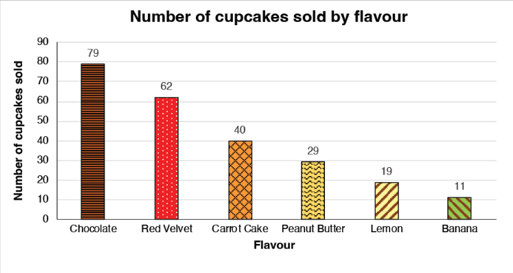

Item 5c Term 2 2023 CAA (61%)
Here is a graph of cupcake sales at a school during Treat Week 2023.
In total 240 cupcakes were sold.
Is it true to say that about one third of sales were chocolate-flavoured cupcakes?
Choose the
best answer that explains whether, or not, the statement is true.
a. Yes, because 79 is very close to one third of 240.
b. Yes, because one third of 240 is exactly 79.
c. No, because 79 is one quarter of 240, not one third.
d. No, because one third of 79 is 26.3333, and that doesn’t divide evenly into 240.
Item 5A Term 4 2023 CAA (63%)
Elections in Aotearoa happen every 3 years.
Last year, in 2023, there was an election.
Was 1987 also an election year?
Choose the best answer.
a. No, because if you count on in threes from 1987, you do not get to 2023.
b. Yes, because 2023 and 1987 are both odd numbers.
c. Yes, because 2023 is 36 years on from 1987, and 36 divides evenly by 3.
d. No, because 2023 is 36 years on from 1987, and 36 is not a multiple of 3.



































